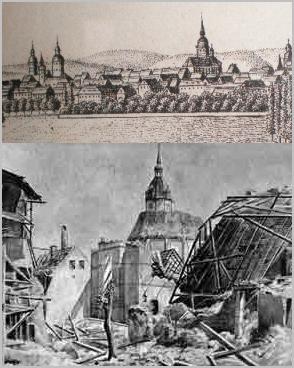


|

|
The ancient city center of Münster was turned to cheese and 91% destroyed by Allied bombing by both British and Americans, with the loss of nearly all historical buildings. With the first air raid on May 16, 1940, an industrial camp was destroyed. By December 23, further attacks followed. In the nights between July 6th and 10th, 1941, the first surface bombardments came. After a large-scale night attack on June 12, 1943, in which the target was the Cathedral entry, and in a daylight raid on October 10, 1943, large parts of the city center were destroyed or heavily damage.
Between September, 1944 and March, 1945 there were 50 more air raids directed at the cathedral city, of which the last and most devastating was on March 25, 1945 toward the end of the war. 112 heavy bombers dropped over 1,800 high impact bombs and 150,000 incendiary bombs. The fabulous cathedral sustained direct hits on the western porch and the nave, and was filled with unexploded bombs, leaving the nave and towers roofless. The Prior responsible for the church treasures was dead. On the evening of April 2, 1945, the Allies took the town anyway. Up to this time there were 1,128 air alarms and 112 air raids in altogether. The bombs amounted to altogether 32,000 high-explosives, 642,000 staff incendiaries and 8,100 phosphorus (napalm) bombs. With the numerous attacks more than 1,600 people died. Of 33,737 dwellings once in the city, only 1,050 remained intact, and more than 60% were mostly or completely destroyed.The infrastructure broke down completely.
Substantial parts of the water pipe lines were destroyed as well as electricity and gas supply. Roads were not any longer passable. 24 schools as well as a majority of the hospitals were destroyed, so that only 400 beds remained to treat the wounded. Standing in place of hundreds of years of history was 2.5 million cubic feet of debris and rubble. Burned out towers of the medieval churches jutted up in the ruined city, the 14th to 18th century buildings all gone. The piled up rubble caused a flood disaster by February of 1946. These gigantic heaps of rubble had to be removed for traffic to flow again. Young kids, women and old people had to do this all over Germany because the men were either dead, missing or prisoners.

On April 9, 10 and 11, 1945, just weeks before the war ended, British and American planes bombed the city destroying or heavily damaging areas of the Old Town and adjacent areas. On April, 12, the city of Naumburg was hit by an American bomb attack which severely affected it. More than 100 people died and about 700 houses were damaged. American troops occupied the city and opened up a notorious prisoner of war camp. Only three months later, the city was handed over to the Red Army. With the influx of refugees and displaced persons, the city held up to 60,000 people.
The first bomb attack from the air was in 1941, followed by more bombings, the worst of them on April 13, 1945. After the end of the War, Neumuenster had a wave of refugees and a severe housing shortage.
Between 1940 and 1945, Allied bombers flew 136 air raids on ancient, medieval Neuss because of its proximity to Düsseldorf, and in ten large scale attacks dropped approximately 12,000 high-explosive bombs, 130 aerial mines, 102,500 staff incendiary bombs, 6,300 phosphorus bombs and 70 phosphorus canisters, destroying the hospital, schools, churches and transforming the ancient city into rubble and killing 900 civilians. On New Years Eve of 1945, they destroyed the medieval center. Only 189 dwellings were still intact out of 7,100 by the end of war.
Its Baroque Schloß (palace) was destroyed in 1945, when it was enslaved by communism, but the palace gardens (Schloßgarten) still exist.
Neuwied was almost 20% destroyed by Allied bombing.
Prince Maximilian of Wied
On August 24, 1944, 11 B-17 Flying Fortresses of Mission 568 bombed the airfield at Nordhausen as a “target of opportunity.” The British repeatedly struck Nordhausen, murdering around 8,800 civilians. On April 3 and 4, 1945 three-quarters of the town was destroyed by more bombing raids. The labor camp nearby was bombed purportedly because it was “mistaken for a German munitions depot” by the US. This bombing killed thousands of inmates which were later erroneously reported as being killed by Germans. 20% of Nordhausen’s civilian population was killed by Allied bombing before the US Army gave it to the communists.
Offenburg was the target of 1944 bomb attacks which, beside the railway facilities, destroyed the bell tower and stained-glass windows of an ancient church.

It was destroyed along with other gems by Allied bombing in 1945. Only a tower fragment remains.